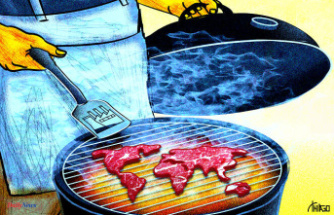Some pluck them out because they destroy what was there. Others cultivate them with devotion in order to create something new: the lupine is either hated or loved depending on its species.
Up to eight hours a day, repeatedly on their knees, stricken by ticks and horseflies, exposed to the weather with no protection: 29-year-old Philipp Frickel and his 61-year-old father Gerd Frickel are exhausted after their day at work on the colorful mountain meadows of the Hochrhön. Since May, the two landscape conservationists and their team of about ten have been targeting the introduced herbaceous lupine (Lupinus polyphyllus) in the UNESCO biosphere reserve.
In the Rhön, a low mountain range between Bavaria, Hesse and Thuringia, conservationists have been fighting the immensely spreading plant for years. Lupine is not just lupine. Because while one species is annoying, the other is grown in the field - and not only serves as animal feed, but also as the basis for vegan dishes or even coffee. It's worth looking at one genus of plants that, depending on the species, inspires anger and enthusiasm.
With a sorrel weevil on the mountain meadow: pierce, lift, tilt - and ideally the perennial lupine is out of the ground together with the taproot. "You have to work very precisely, very cleanly," explains Philipp Frickel. Because if root parts remain, the work was in vain. "They simply form new plants, and next year I suddenly have two lupins here." They want to dig up to 50,000 plants by October. Volunteers are out and about with their scythes and remove lupines that are standing alone between arnica, devil's claw and orchids.
A snow groomer converted into a giant mower attacks the wettest, nutrient-poor but species-rich meadows where manual labor is no longer of any use. And the full-time diggers around the Frickels move in with the weed pullers when there are only a few specimens left. "We call them 'Soko Lupine'. They give the lupine the deathblow, so to speak," says Torsten Kirchner, biologist and area manager of the high plateau called Lange Rhön.
Up to 700 hectares of the approximately 3000 hectare high plateau are threatened by the perennial lupine. Since the plant can bind atmospheric nitrogen, the mountain meadows are enriched with nutrients and changed for many years, explains Kirchner. Nitrogen-loving plants such as the stinging nettle, the stinging hollow tooth or the bedstraw followed and displaced arnica, globe flower and Co. - the landscape changes. If the perennial lupine gets the upper hand, breeding areas for rare bird species could be lost.
But there are also coveted lupins. "In contrast to the wild forms, sweet lupins are low in bitter substances, i.e. the alkaloid content in the grain is less than 0.05 percent," writes the Bavarian State Institute for Agriculture (LfL). Up until the 1990s, lupine cultivation was widespread in Germany's fields, says Markus Heinz, head of the crop production and testing department at the agricultural colleges in the Middle Franconia district in Triesdorf. But then a fungal disease hit the plants and led to total losses for the farmers. Cultivation has almost come to a standstill.
In 2001, experts in Triesdorf began to breed their own varieties of white lupine (Lupinus albus) that are not susceptible to plant diseases. With success, as Heinz emphasizes: In 2019, two varieties were approved. "There is a lot of interest," says the expert. "Many farmers are dealing with it intensively."
So far, the lupine has been a niche product as a food. According to LfL information, lupins were cultivated on around 28,900 hectares across Germany. Corn grew on about 2.65 million hectares. Domestic lupins are mainly used as protein-rich animal feed and could therefore become a substitute for soy imports. Feeding trials with dairy cows went very well in Triesdorf, says expert Heinz. The use of lupins in pig and cattle fattening is currently being tested.
But lupine products are also suitable for human consumption: lupine ice cream as a vegan alternative to cream ice cream or lupine flour as an alternative to ground grain. Sabine Bittel from the Department of Nutrition and Home Economics at the Triesdorf School has other suggestions: you can marinate the lupine seed and eat it as a salad. Lupine meal, soaked for ten minutes, is suitable as a minced meat supplement or substitute. In addition, people in Triesdorf have started to roast and grind lupins and brew them as coffee. "It works great," says Bittel. The fat content is similar to that of coffee beans, while roasting creates a nutty aroma.












